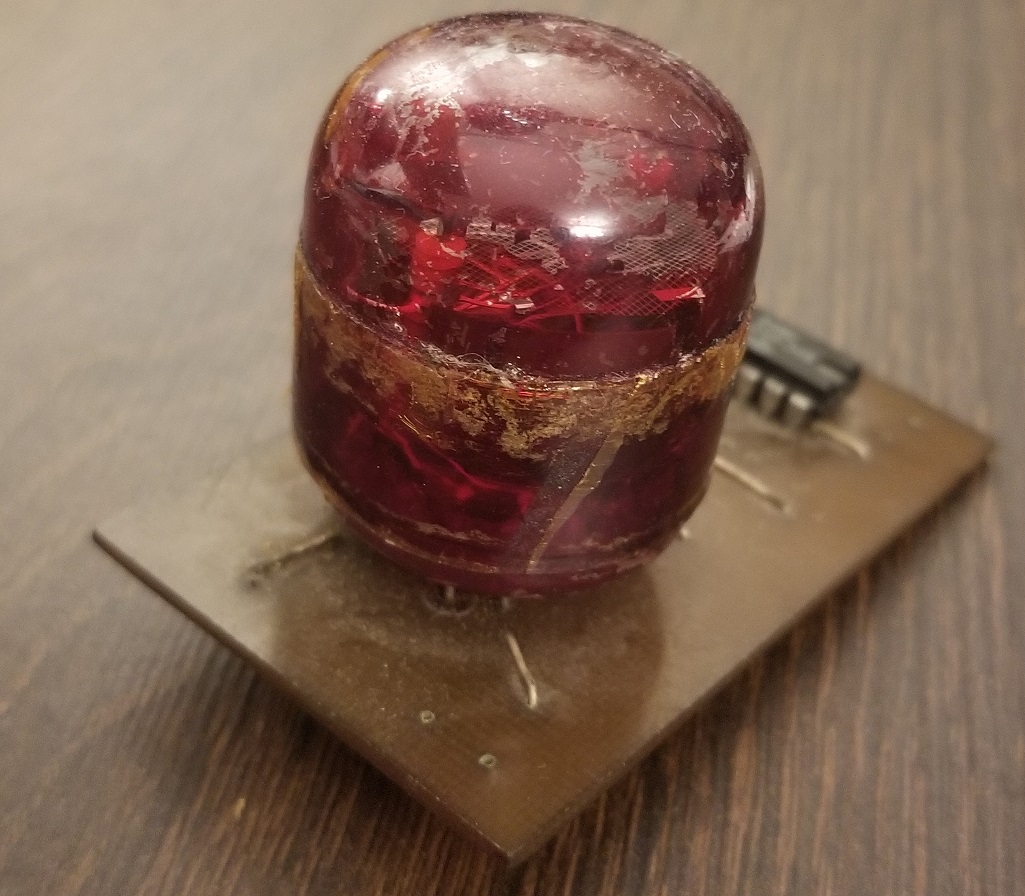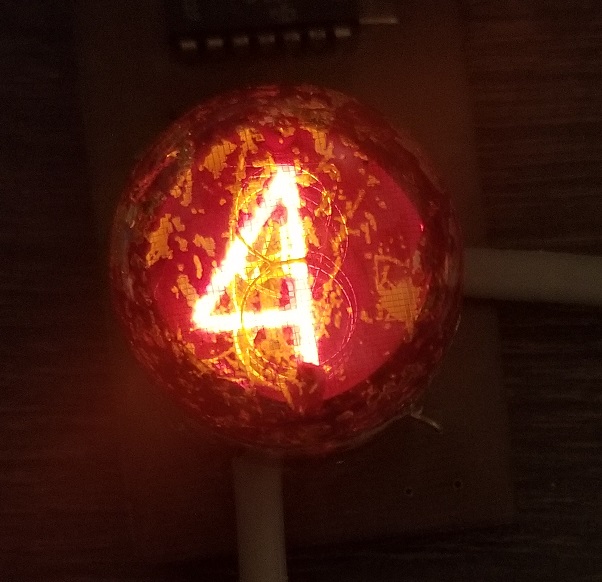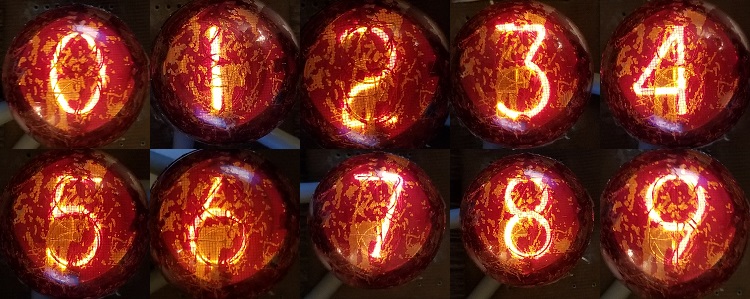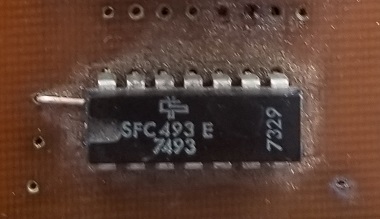Please help identifying a nixie tube.
118 views
Skip to first unread message
Bartek Ogryz
Sep 17, 2021, 7:34:36 PM9/17/21
to neonixie-l
Hi!
I'm trying to identify an unknown nixie tube. You can see it on a photos (I'm not able to do a better ones right now). The tube is red coated. It had a label with model name, but it's missing. It displays digits from 0 to 9, the digit height is about 19 - 20mm. Tube dimensions are: ~35mm height and ~30mm diameter. It has no socket, the leads are soldered to board.
Any ideas, what can it be?
Bartek.



martin martin
Sep 17, 2021, 7:51:41 PM9/17/21
to neoni...@googlegroups.com
Looks like a Borroughs to me.
I’ll get the PN when I’m off the road.
Martin
--
You received this message because you are subscribed to the Google Groups "neonixie-l" group.
To unsubscribe from this group and stop receiving emails from it, send an email to neonixie-l+...@googlegroups.com.
To view this discussion on the web, visit https://groups.google.com/d/msgid/neonixie-l/5d771d8c-c8cd-48db-a1d4-2188babfa654n%40googlegroups.com.
liam bartosiewicz
Sep 17, 2021, 10:07:16 PM9/17/21
to neoni...@googlegroups.com
Who made the IC on the pcb? Could give a clue as to where it’s from
On Sep 17, 2021, at 4:34 PM, Bartek Ogryz <bartek.f...@gmail.com> wrote:
Hi!
I'm trying to identify an unknown nixie tube. You can see it on a photos (I'm not able to do a better ones right now). The tube is red coated. It had a label with model name, but it's missing. It displays digits from 0 to 9, the digit height is about 19 - 20mm. Tube dimensions are: ~35mm height and ~30mm diameter. It has no socket, the leads are soldered to board.Any ideas, what can it be?
Bartek.<nixie.jpg><nixie2.jpg>
--
You received this message because you are subscribed to the Google Groups "neonixie-l" group.
To unsubscribe from this group and stop receiving emails from it, send an email to neonixie-l+...@googlegroups.com.
To view this discussion on the web, visit https://groups.google.com/d/msgid/neonixie-l/5d771d8c-c8cd-48db-a1d4-2188babfa654n%40googlegroups.com.
<nixie.jpg><nixie2.jpg>
Greg S
Sep 18, 2021, 8:22:17 AM9/18/21
to neonixie-l
I am almost sure it is a russian IN-1 tube extracted from the base and coated red.
Audrey
Sep 18, 2021, 8:24:50 AM9/18/21
to neoni...@googlegroups.com
hmm interesting thought. Bartek should try seeing what the 5 looks like...
--
You received this message because you are subscribed to the Google Groups "neonixie-l" group.
To unsubscribe from this group and stop receiving emails from it, send an email to neonixie-l+...@googlegroups.com.
To view this discussion on the web, visit https://groups.google.com/d/msgid/neonixie-l/72ba3f85-415f-42e2-92b9-f68426b960ben%40googlegroups.com.
Bartek Ogryz
Sep 18, 2021, 8:56:38 AM9/18/21
to neonixie-l
Very interesting, Greg. I think you're right, that it's a russian tube. But I'm not sure, if it's an IN-1 - all digits are similar, except digit "5", wchich is not an inverted "2" (it's normally shaped). I'll place some more photos later.
Thank's,
Bartek.
Audrey
Sep 18, 2021, 8:58:03 AM9/18/21
to neoni...@googlegroups.com
Interesting. I believe there were some IN-1s made with regular 5s but I dont know what other tube it could be.
To view this discussion on the web, visit https://groups.google.com/d/msgid/neonixie-l/7a84d802-149e-4520-b8e6-9d13f4c6ae84n%40googlegroups.com.
Bartek Ogryz
Sep 18, 2021, 5:08:26 PM9/18/21
to neonixie-l
Here are some new photos. Note that the brown glue is on the red paint, so if it's IN-1, it had to be coated before placing in a base, I think. It has 14 leads, but 3 of them are short cut.


The IC i SFC493E.



Bartek.
chuckrr
Sep 18, 2021, 5:35:36 PM9/18/21
to neoni...@googlegroups.com
With a 14 pin driver IC, this has almost certainly GOT TO BE a bi-quinary style nixie.
To view this discussion on the web, visit https://groups.google.com/d/msgid/neonixie-l/5c516a9b-fbbb-4c3c-babb-7b802cff11dbn%40googlegroups.com.
Dekatron42
Sep 18, 2021, 5:47:50 PM9/18/21
to neonixie-l
The SFC493E is designated as a 4-bit binary counter and from the photo you can see 8 holes in a straight line which probably means that there has been a Nixie driver like the 7441/74141 or similar soldered there (if there are 8 more holes outside of the photo).
/Martin
Audrey
Sep 18, 2021, 5:50:21 PM9/18/21
to neoni...@googlegroups.com
Ah that makes sense Martin! I was very sure that wasnt the whole circuit as that didnt quite make sense to me.
To view this discussion on the web, visit https://groups.google.com/d/msgid/neonixie-l/26b3855c-ee67-459c-a182-5af7c54e359dn%40googlegroups.com.
Greg S
Sep 18, 2021, 6:02:00 PM9/18/21
to neonixie-l
Hi Bartek,
This is my IN-1 tube on the video. https://youtu.be/kZPFIaihm7s
This is an old version with regular 5 from 1971. Note the number 4, this is also different from later versions, but seems to be the same as yours. Tube diameter is ~30mm. Other dimensions I can not tell, as I won't extract it from the base. Also here is a photo to see the anode mesh. Please compare.
This is my IN-1 tube on the video. https://youtu.be/kZPFIaihm7s
This is an old version with regular 5 from 1971. Note the number 4, this is also different from later versions, but seems to be the same as yours. Tube diameter is ~30mm. Other dimensions I can not tell, as I won't extract it from the base. Also here is a photo to see the anode mesh. Please compare.
liam bartosiewicz
Sep 18, 2021, 6:04:18 PM9/18/21
to neoni...@googlegroups.com
Could be an IN-4, I’m pretty sure those can be used as biquinary tubes.
> On Sep 18, 2021, at 2:35 PM, chuckrr <chu...@all2easy.net> wrote:
>
> almost
> On Sep 18, 2021, at 2:35 PM, chuckrr <chu...@all2easy.net> wrote:
>
> almost
chuckrr
Sep 18, 2021, 6:24:34 PM9/18/21
to neoni...@googlegroups.com
Biquinary tubes require 7 wires to the outside world. there are 2 separate anodes, a front screen and a back plate.
The digitsand wired together internally within the tube in (5) odd-even pairs. Those pairs are 1-2, 3-4, 5-6, 7-8, 9-0
The evens are near one side of tube, odds near other side. They are separated by a middle screen which is also brought out.
Must hook a 1 meg resistor from middle screen to each digit pair, so add (5) 1 meg resistors 1 each from middle screen to
each digit separately. This cuts off ghosting of unwanted digit in any pair. Make desired anode positive and take the cathode
pair to GND. Appropriate digit will illuminate. They did this to cut down on driver transistors. Only 7 required per tube instead of the usual 10.
---- Original Message ----
From: "liam bartosiewicz" <liambart...@gmail.com>
Sent: 9/18/2021 6:04:19 PM
To: neoni...@googlegroups.com
Subject: Re: [neonixie-l] Re: Please help identifying a nixie tube.
</chu...@all2easy.net></liambart...@gmail.com>
The digitsand wired together internally within the tube in (5) odd-even pairs. Those pairs are 1-2, 3-4, 5-6, 7-8, 9-0
The evens are near one side of tube, odds near other side. They are separated by a middle screen which is also brought out.
Must hook a 1 meg resistor from middle screen to each digit pair, so add (5) 1 meg resistors 1 each from middle screen to
each digit separately. This cuts off ghosting of unwanted digit in any pair. Make desired anode positive and take the cathode
pair to GND. Appropriate digit will illuminate. They did this to cut down on driver transistors. Only 7 required per tube instead of the usual 10.
---- Original Message ----
From: "liam bartosiewicz" <liambart...@gmail.com>
Sent: 9/18/2021 6:04:19 PM
To: neoni...@googlegroups.com
Subject: Re: [neonixie-l] Re: Please help identifying a nixie tube.
--
You received this message because you are subscribed to the Google Groups "neonixie-l" group.
To unsubscribe from this group and stop receiving emails from it, send an email to neonixie-l+...@googlegroups.com.
To view this discussion on the web, visit https://groups.google.com/d/msgid/neonixie-l/158CEF37-98C3-44F0-8755-26E3F85C56FB%40gmail.com.
You received this message because you are subscribed to the Google Groups "neonixie-l" group.
To unsubscribe from this group and stop receiving emails from it, send an email to neonixie-l+...@googlegroups.com.
</chu...@all2easy.net></liambart...@gmail.com>
Bartek Ogryz
Sep 18, 2021, 6:37:59 PM9/18/21
to neonixie-l
@Greg: YES :) It's an IN-1 for sure. Thank you!!!
@LB: It's not biquinary. It has 14 leads placed in the glass, but three of them are not used - they are cut very short (one of them is visible on photo),
@Chuck: Russian IN-4 has no internal connections between odd and even digits. It has 14 leads and can be used either as a biquinary tube, or a single anode tube,
Sorry, I forgot to mention, that the IC is not a driver, but a logic circuit. The driver is missing on the board.
So the mystery is solved! My tube is an old IN-1 extracted from the base, then red coated. That brown glue is not a glue - it's an adhesive tape :D
Many thank's to all of you!!!
Bartek.
Reply all
Reply to author
Forward
0 new messages
